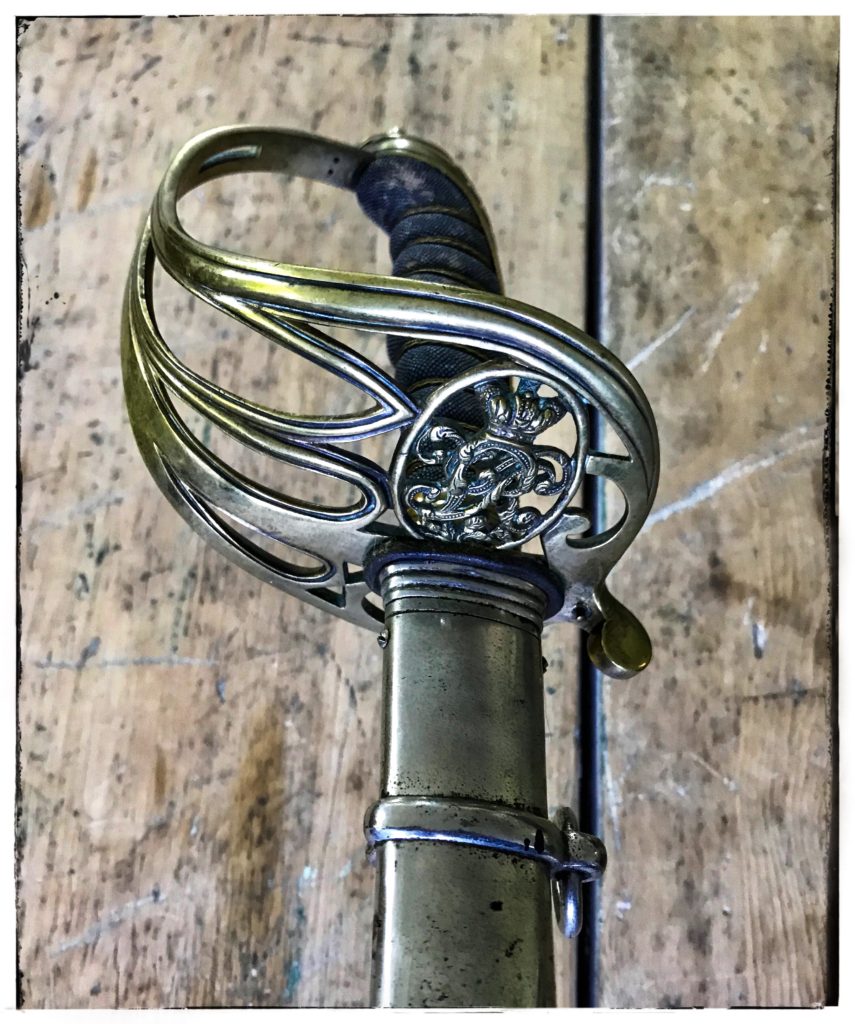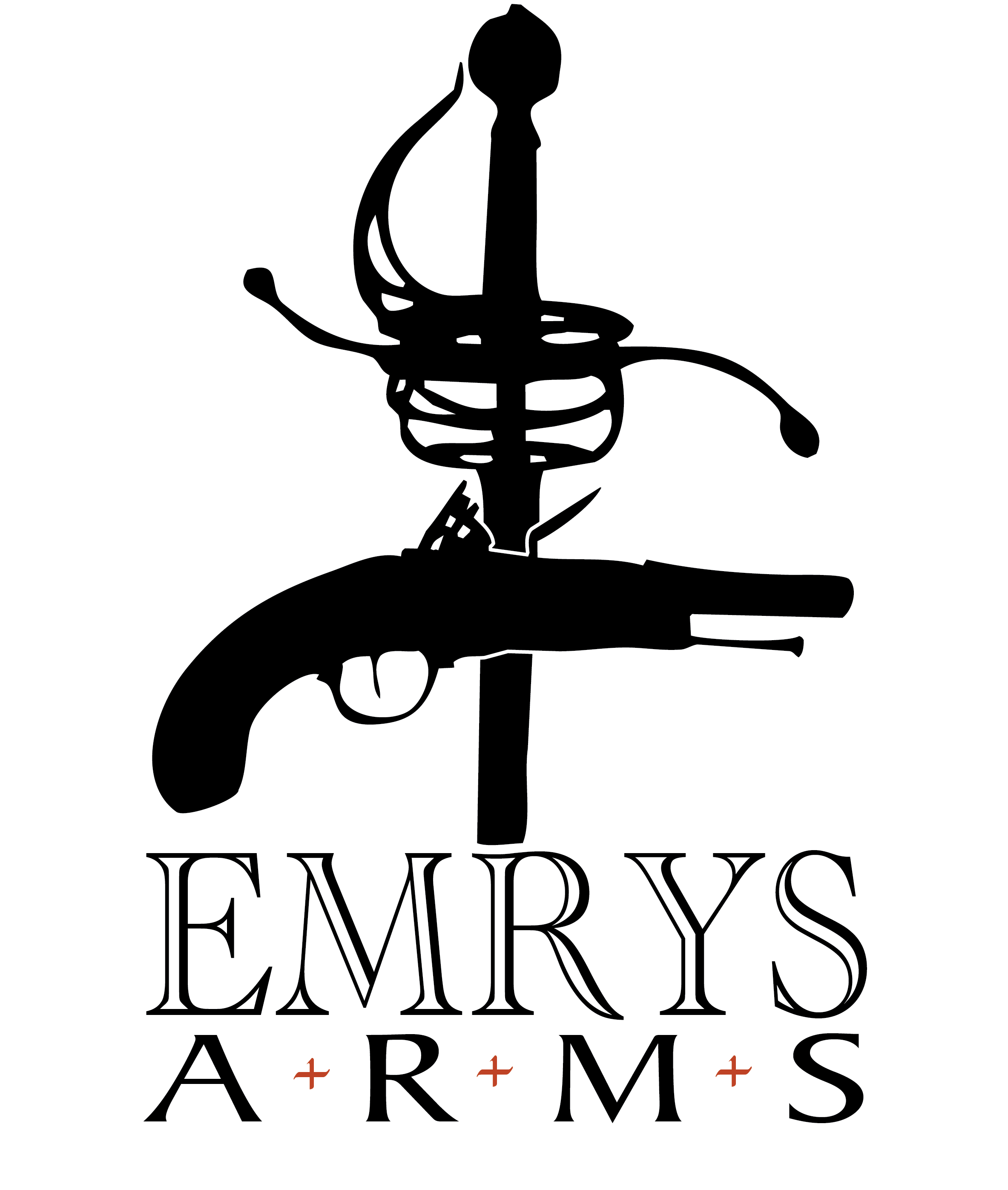| Collection #: | 2020.013 |
|---|---|
| Type: | Infantry Officer |
| Nationality: | British |
| Pattern: | 1854 |
| Date: | 1854 - 1892 |
| Hilt: | Brass |
| Blade Length: | 88.5cm (34 7/8") |
| Blade Width: | 2.9cm (1 1/8") |
| Overall Length: | 103.5cm (41 1/8") |
| Retailer / Outfitter: | J. Martin & Co. ~ Montreal |

This pattern of sword is a further development of the 1822/45 pattern, which in turn was an evolution of the original 1822 pattern (Sword 2020.011). “In 1854, the hinged flap of the guard was abolished and the S-shaped insert in the flap was replaced in infantry of the line swords by a single curved spur….In the same Regulations of 1854, adjutants re-adopted the steel scabbard which had been abolished in the 1834 Regulations and in the following year (1855) the cross belt was finally abolished and, with it, the need for a frog stud on the locket. Henceforth, all scabbards were to be carried on slings, (which could be hooked up to the waist belt on parade), until the brown leather scabbards introduced in the 1890s.”
This is an excellent intact example to study this pattern. The brass guard is in very good undamaged condition with remnants of old polish still to be removed. Two pin holes at the top of the knuckle guard and a rivet where the quillon begins give testimony to the leather lining it once had which was abolished in the early to mid-1870s. It contains the Victorian royal cypher incorporating the rose, thistle and shamrock introduced in the early 1850s (which only makes sense as it is an 1854 pattern) nestled in the outward bars. The fish skin grip has little to no loss but is interestingly slightly mottled. I am unsure as to whether this is due to age or naturally occurring in the organic material. The backstrap of the guard has now acquired a checkered pattern for better grip of the thumb which proceeds from the ferule to almost halfway up the backstrap.
The slightly longer than regulation length blade is completely free of rust and while the engravings are still relatively crisp, the bright metal is starting to cloud over as it slowly darkens with age. The right side blade engravings begin with the Star of David surrounding a brass proof slug incorporating the word PROVED around a fleur-de-lis.
The brass proof slug was placed there by the blade maker. It is intended, though sometimes used unscrupulously, to declare that the blade has been tested and found to be of good quality. It is an evolution of the marks left by blade makers to warrant or declare the quality of the workmanship of their blade. While it is generally accepted that the blade maker Wilkinson (who finally ceased sword production in 2005) was the first to introduce widespread use of the brass proof slug in the 1850’s “we are on safer ground when we declare that the incorporation of a Star of David symbol enclosing the brass disc is probably Wilkinson in origin. The Star of David symbol and the brass proof mark was soon imitated by other sword-makers, regardless of whether they had actually tested the sword blade.”
There are many different designs of brass proof slugs and it is sometimes the only way to tell who the blade maker is (different from the blade retailer or outfitter). This particular design of brass proof slug (there are many), could have been Mole or William & Anderson or Dudley or Reeves to site a few examples. Several books can be researched to help you identify the brass proof slug in your sword. The book listed above by Harvey Withers has many diagrams as does the much scarcer book Swords for Sea Service by Annis and May, but they seem to be far from concrete evidence as the proof mark design on this blade does match three or four examples in these books all by different makers. But it is something and when you are trying to solve a mystery, you need as many hints as you can get!
The engravings then flow into a floral design. The remainder of the blade is one large 32cm decorative motif (not exactly floral – see pictures below) with a crowned VR in the centre. The left side blade engravings are identical except at the forte. Here we have the retailer marking of J. Martin & Co. Montreal. Finding out the dates of operation for this outfitter could potentially narrow down its date of production. However, I have so far been unsuccessful at tracking down dates of Canadian military outfitters.
The scabbard, while showing greater evidence of rusting over the years, has performed its job by protecting the blade. Structurally it is sound. Both loose rings are present as is the mouth piece with both screws. The sword still fits tightly in the scabbard and does not rattle or fall out if you hold it upside down.
To give you an idea as to how long this pattern of sword was in service, Robson again relates in his book (starting with the 1845, which this is only a slight modification of), that it “lasted throughout the great period of Victorian military campaigning – the Second Sikh War, the Crimea, the Indian Mutiny, the Maori Wars, Ashanti, the Zulu War, the Second Afghan War, the Sudan and a host of minor expeditions” (Page 164).
We use cookies to improve your experience on our site. By using our site, you consent to cookies. Enjoy the cookies...they're delicious...
Websites store cookies to enhance functionality and personalise your experience. You can manage your preferences, but blocking some cookies may impact site performance and services.
Essential cookies enable basic functions and are necessary for the proper function of the website.
Statistics cookies collect information anonymously. This information helps us understand how visitors use our website.
Google Analytics is a powerful tool that tracks and analyzes website traffic for informed marketing decisions.
Service URL: policies.google.com (opens in a new window)

